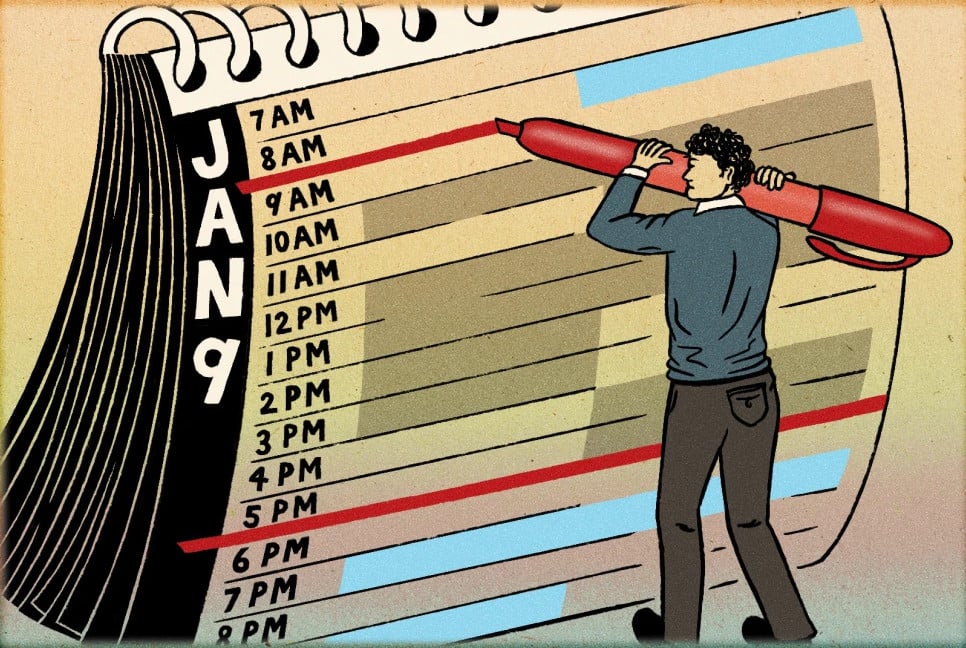Early in his career, Justin Stewart balanced multiple jobs to make ends meet.
He worked as a full-time news show production assistant from 3 a.m. until noon, then rushed to another job renting cars at an airport or pulling shifts in retail stores, reports AP.
At times, he even slept in his car between jobs. Eventually, he was hospitalised for exhaustion and a staph infection.
“While people around me admired my hustle, I paid the price in the end,” Stewart recalled. “The doctor told me, ‘You’re too young to be this stressed. You need to quit something.’”
Now 36, Stewart began setting boundaries. He let go of side jobs, realising he could manage without extra income. If colleagues contacted him after hours, he made it clear he was off-duty and offered an alternative contact.
Setting boundaries in work and life can be difficult. Many struggle to say no, particularly to a manager, while others enjoy the satisfaction of being needed or pleasing others.
However, experts emphasise that learning to decline requests is crucial for safeguarding physical and mental health. Like any new skill, establishing boundaries becomes easier with practice.
Well-being experts and organisational behaviour specialists, along with other workers, shared strategies for setting limits.
Schedule Intentionally
Although adding tasks to your calendar may seem counterproductive when trying to reduce your workload, it can help you take better control of your time.
Bobby Dutton, founder of event production company GBM6, uses a method called “aggressive calendaring.” He schedules tasks he’s prone to procrastinate on, like handling contracts, for every Monday at 2 p.m. To avoid overload, he also books time for regular tasks such as making coffee, walking the dog, and eating lunch.
Prepare a Script
For those unaccustomed to saying no, it can help to write down what you’ll say and rehearse it. Stewart practised informing colleagues when his workload became overwhelming, using phrases like “This is a lot for me” or “You gave me seven stories; I can manage four or five.”
Cara Houser, a workplace engagement coach, suggests you don’t need to justify your refusal. You can simply say you’re unavailable at that time, followed by “Thanks for asking, and I hope to have more capacity next time.”
If the person argues, Houser advises responding with, “I understand how you feel. But I’ve decided to handle things this way today.”
Entrepreneur Amber Krasinski, raised in a working-class environment where refusing a boss could mean losing pay, often uses “Not yet” when turning down a project.
“That phrase has helped me in many situations,” she said.
It can be tempting to agree right away when asked to help, but sometimes stepping back is the better choice. Before responding to a new request, take five minutes to assess your workload, energy, and priorities, suggests Israa Nasir, a New York-based psychotherapist.
Nasir recalls how a former boss would frequently text work-related queries at 10 p.m. on weekends. Instead of saying, “Don’t text me,” she proposed, “Can we check in before the weekend so I can plan my time?”
Nasir also advises keeping track of activities or interactions that leave you feeling drained. Add these to a “No List” — a tool to help decide when to decline, though it doesn’t mean you reject every request.
Use Technology Wisely
Mobile devices make it easier to work from anywhere, but they can blur the line between work and personal time. However, there are ways to limit distractions.
After realizing she checked email too often on weekends, Nasir moved her Gmail app to the second page of her iPhone from Friday night to Sunday night.
Email signatures can also help manage expectations. Candice Pokk, a senior consultant in organizational effectiveness at Segal, includes a “Well-Being Notice” in her emails that reads, “Receiving this email outside normal working hours? I’ve sent this at a time that works for me. Please respond when it suits you.”
Be Selective About Meetings
With online meetings becoming more common, it’s easy for others to fill your calendar with invitations. Accepting all invites can leave little time for other tasks.
Janine Pelosi, CEO of video technology company Neat, believes workers should feel free to leave meetings that aren’t relevant, if the work environment allows it.
If unsure about the value of a meeting, Pelosi recommends requesting an agenda or asking for the desired outcome in advance.
Set Time Limits
Lori Perkins, 65, worked long hours until a cancer diagnosis changed her routine. During chemotherapy, she could only manage about four hours a day, feeling sluggish and drained.
After treatment, Perkins realized she would survive and questioned whether she wanted to continue at the same pace. She now limits her work as owner of Riverdale Avenue Books to around 50 hours per week, reducing her manuscript reviews. Rather than send rejection letters, she tells authors to check back in a few months when it’s less hectic.
She practices saying “no” in her head and journal, recording her experiences. This has given her time to enjoy museums, friends, and theatre.
“No changed my life,” Perkins said. “I’m a different person now because I truly embraced saying no.”
bd-pratidin/Rafid




























































